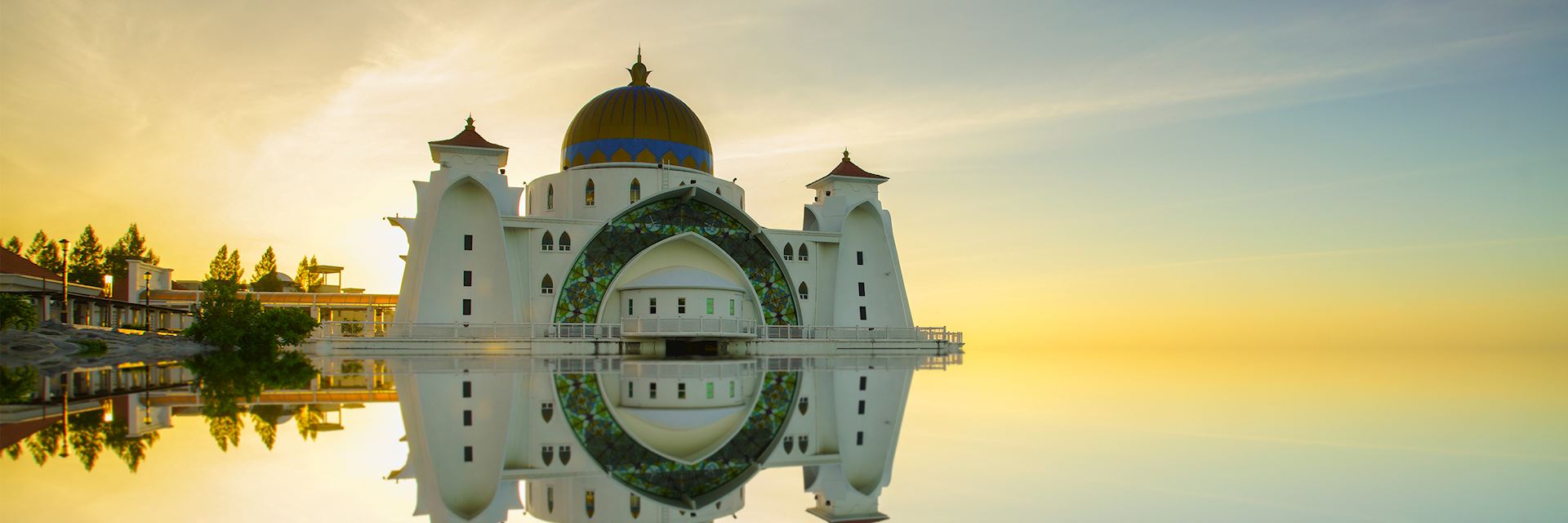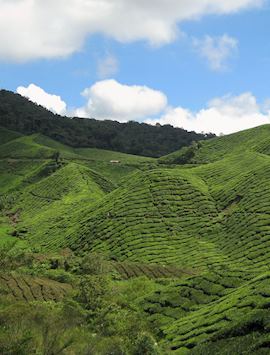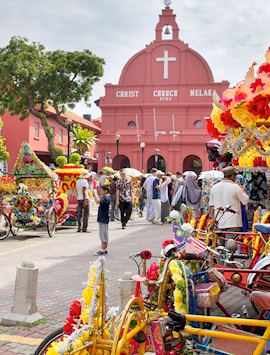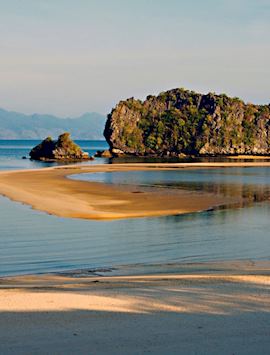By Malaysia specialist Katie
Before joining Audley I took an extended career break, journeying extensively through Southeast Asia. Exploring on my own, I found a part of the world where I always felt safe and where getting around was refreshingly simple. It’s for these reasons I always recommend the region to families.
Malaysia in particular has a balance of cultural sites and exciting experiences, comfortable hotels and great local guides. It’s a country suited to active family holidays: you can clamber over the thick boughs of trees on a walk through the rainforest, and be back at the hotel in time for a dip in the pool.
It’s a destination for families who are prepared to travel, although you can make journeys more comfortable with your own car and driver. This gives you the flexibility for plenty of breaks. The English-speaking drivers can also act as your guide and you’ll find them keen to narrate the stories behind the scenery you pass through.
Starting with Malacca’s colonial streets

You’re most likely to fly into Kuala Lumpur, Malaysia’s only international airport. Before heading north to explore the highlands and beaches, I suggest taking a little detour two hours south to Malacca (you can then stop to explore Kuala Lumpur city on your return northwards). Awarded UNESCO World Heritage Status in 2008, this laid-back coastal city is an assortment of Portuguese townhouses, old Dutch churches and domed mosques.
On a full-day tour with a driver and guide, I explored every facet of the city. We started with a walking tour of the central colonial region, which is small enough to explore on foot (and the car is on hand to ferry you between sights if you need it). You can also explore on a trishaw (a local cycle-rickshaw), driven by your guide.
One unassuming building tucked away from the main street turned out to be a museum showcasing the traditional technique of foot binding. It’s fallen out of practice now but was once a key part of society: the smaller the foot, the more desirable the woman. One of the shoes was so tiny it fitted into the palm of my hand.
Our driver then drove us to a small jetty, where we caught a boat up river. From the boat you’re able to appreciate the historic, brightly whitewashed waterfront houses. Malacca began as a fishing village and, as we journeyed up river, we began to see fishermen’s enclaves. Vividly painted stilt houses edged the river, wooden longtail boats lined up in neat rows below.
I particularly recommend Malacca for its street food. Head to Jonker Street, which runs through Chinatown, in the evening and you’ll find the pavements lined with stalls. Laksa curry, a spicy noodle soup, is a delicacy here, and I sampled quite an array of different types. Most varieties are spicy, but ask a local patron to point you in the direction of a stall selling a milder version and they’re normally happy to oblige.
Family-friendly hotels in Malacca

Stay at Majestic Malacca and you’re within walking distance of Jonker Street. The hotel is set on the edge of the river — the views are best from the Melba restaurant. Part of the hotel is an original 1920s mansion, decorated with stained glass and ties imported from Europe. Modern wings now flank the original building, housing a spacious pool area and some of the larger suites.
Exploring Kuala Lumpur

From Malacca, I suggest heading back up to Kuala Lumpur for a few nights — logistically it makes sense to work your way north through Malaysia.
For children, I think Kuala Lumpur is a great introduction to Asia. They can gaze up at modern spectacles like the Petronas Towers then dive into a little patch of inner-city jungle next door. A walking tour through areas like Little India showcases the types of flower markets, sari sellers and chai wala (tea sellers) that you’d see in Delhi or Mumbai. As for places of worship, there are examples of almost every persuasion: Buddhist pagodas, Chinese temples, Christian churches, and mosques.
The shopping complexes could keep older children and teenagers occupied for hours: the multi-storey Berjaya Times Square mall even has a rollercoaster running through two levels. The dining hall on the top floor is a popular haunt for local people and a good spot for lunch.
Take a street food tour of Kuala Lumpur

To delve deeper into Kuala Lumpur’s food scene, I took a tour in the early evening with a local guide. From the starting point of my hotel, we crossed the city on the tram system — a good way to get your bearings. Weaving through brightly lit Chinatown, we stopped every few steps to try roasted duck, wantan mee (noodle broth with dumplings) and sticky rice. Arriving in Little India, we squeezed onto a table in a busy restaurant, where my guide suggested a curry dish. A thick fish curry arrived, served on a banana leaf and with no cutlery — as is the custom, I ate the dish with my hands, elbow to elbow with the local diners.
Discover the Cameron Highlands

First mapped by a British surveyor in 1885, the Cameron Highlands became a rural retreat from the humidity of Kuala Lumpur for British colonists. The highlands are a three-hour drive from the city, and along the route you’ll pass rich-green tea plantations, wild patches of jungle and neatly cultivated farms.
There’s still a holiday-town feel around this hill station, although some areas are in need of a bit of care and attention. Timber-beamed buildings and European-styled cottages with French doors open out onto little courtyards. A number of colonial buildings have been repurposed into boutique hotels. I find the Cameron Highlands Resort works well for families: the two-bedroom suite can comfortably sleep a family of four.
During one stay, I joined a small group tour of a nearby tea factory. The guide talked us through the process from leaf to cup, in a way that would keep children entertained for the 40 minutes the tour lasts.
Take an evening hike along jungle paths

While the majority of land is used for agriculture, you’re not far from the jungle. My guide and I ventured out in the late afternoon for a half-day walk through a section of nearby rainforest. We drove to one of the highest points in the highlands above the tea plantations and, as the sun began to set, watched the sky turn a buttery yellow. I was then handed a torch and we set off along a narrow track.
It didn’t take long before we were enclosed in foliage, the thick tree canopy above, the forest floor almost bouncy with grasses and ferns. Clambering over moss-covered tree roots, we paused regularly to search for insects and birds. My guide pointed out pitcher plants poking up from the undergrowth, ready for the next unsuspecting insect or, on occasion, a mouse.
Learn about Penang’s multicultural history

Heading north, and descending from the highlands, you’ll find the small state of Penang. The capital, George Town, sits on Penang Island, reached by suspension bridge, and is a convenient base for the area. Originally an 18th-century trading post, the British encouraged free trade in Penang to entice merchants away from the Dutch-controlled ports to the south.
Merchants from China to Europe began to settle in Penang: immigrants were invited to claim as much land as they could clear. This created a multicultural enclave that still exists today, a by-product of which is the cuisine — years of sharing recipes and cooking techniques have led to a vibrant food culture.
I suggest visiting the Red Food Market, where Malaysian, Chinese, Indian and Burmese dishes are cooked side by side. If you travel from June to August you’ll hit durian season. These smelly, spiky fruits are surprisingly popular and, as they’re only available for a short period, are celebrated with aplomb. Stalls sell the fruits in different guises, including ice cream, pastries and curries.
During my stay, I took the vernacular railway that runs from the outskirts of George Town to Penang Hill, which rises above the city. The small, squat train journeys through tunnels and under bridges at steep angles up the hillside. At the top is a mosque, a Hindu temple covered with vibrantly painted statues and a number of souvenir shops.
Navigate Penang National Park’s rivers by boat

As with most cities in Malaysia, you’re not far from nature in George Town. Penang National Park is a few hours’ drive from the city and best explored by boat. My guide and I arrived first at the fishing village of Kuala Sungai to meet our boatman for the day. As we paddled through the meandering waterways of the mangroves, I spotted some giant mudskippers sloshing through the shallows and monitor lizards basking on the banks.
I suggest staying on the boat if you have young children. For older families, you can disembark to trek through the surrounding dipterocarp forest. The ground is quite challenging, but you eventually emerge at Pantai Kerachut, a meromictic lake you can paddle in before enjoying a packed picnic.
Family-friendly beach hotels in Malaysia
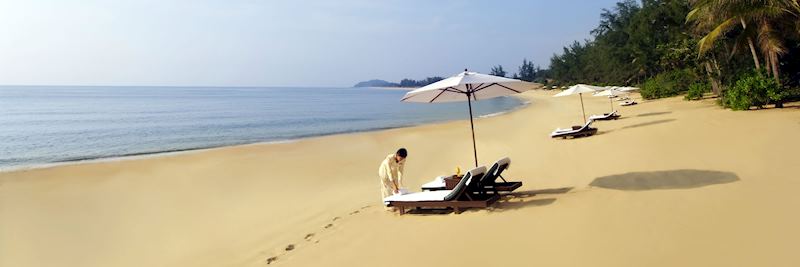
Malaysia’s two coastlines have completely different weather patterns, which you should consider when planning your trip. The west coast is at its best from October to March, while the east coast has clear skies from May to September (April being a transitional month).

The east coast: for waters teeming with marine life
The waters of Malaysia’s east coast shelter some of the best snorkelling and diving sites I’ve ever seen. Hotels run boat trips out to the reefs, where shoals of glimmering barracudas and humphead parrotfish flit among the coral. Life jackets are provided, but this activity is best suited to confident swimmers.
Younger children can enjoy splashing about on the flaxen sand. The hotels here have been sensitively built into the landscape behind the foliage that runs along the beach, which gives an untouched island feel.
The Tanjong Jara Resort is built in the style of a traditional Malay village on a secluded crescent of beach. It’s my family recommendation for its extensive activities menu. You can play sepak takraw, a Malaysian ball game similar to volleyball, or learn to craft paper flowers, a technique used for making temple offerings.
Each morning there’s a sucimurni session, a stretching class of simple movements based on animal characteristics, which is ideal for children.
Stay from June to August and there’s a good chance you’ll see nesting turtles at the nearby turtle sanctuary. Each afternoon (aside from Sundays) the hotel runs a guided walk up adjacent Jara Hill, which was once an ayurvedic garden. You’ll learn about the uses of different plants, often encouraged to try them out yourselves.
The west coast: for gentle, family-friendly waves

The mirror-like waters of Malaysia’s west coast offer some of the country’s calmest seas and super-soft sand that leads gradually into the sea. The island of Langkawi offers some of the west coast’s best stretches — it’s a short flight from Penang or Kuala Lumpur, hanging offshore from the Malay-Thai border.
Langkawi isn’t a large island (you can drive around it in a couple of hours) and, despite becoming a popular beach destination, it’s yet to suffer from overdevelopment. Along one of the longest sections of beach, the Meritus Pelangi Beach Resort & Spa has a family focus, with a children’s club, babysitting service and plenty of pool slides.
Have a big-city adventure in Singapore

Perched on the northern tip of Peninsular Malaysia, Singapore is a short flight away from Kuala Lumpur. With a well-connected international airport, it’s a convenient stopover to finish your trip.
The city’s smart hotels and ambitious architecture add something a little different. Children aren’t an afterthought in this modern city: every museum has a hands-on aspect, hotels have family-friendly facilities and the list of activities aimed at families seems endless.
Most attractions are concentrated on Sentosa Island to Singapore’s south. It’s essentially a giant entertainment hub, with a Universal Studios theme park, the S.E.A. Aquarium (one of the largest in the world) and the Adventure Cove Waterpark, as well as a host of smaller rides and activities.
If your children love wildlife, Singapore Zoo has almost 3,000 resident creatures. Covering a large area around the Upper Seletar Reservoir to the north of the city, it’s also one of the most spacious zoos in the world. At times, it’s easy to forget you’re actually in a zoo and you can spend all day there.
The Night Safari, a separate section of the zoo, opens in the evening, giving you the opportunity to see nocturnal animals in their natural environment.
Children haven’t been overlooked in the heart of the city either. The futuristic Gardens by the Bay has a specially designed children’s garden with slides, water fountains and interactive exhibits. Stay until the evening and you can watch the towering ‘Supertrees’ — giant tree-like structures of concrete and steel — illuminated in the daily sound-and-light show.
Start planning your family trip to Malaysia
Start thinking about your experience. These itineraries are simply suggestions for how you could enjoy some of the same experiences as our specialists. They’re just for inspiration, because your trip will be created around your particular tastes.
View All Tours in Malaysia
